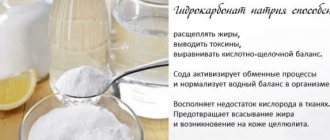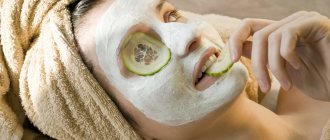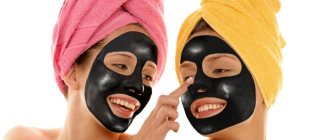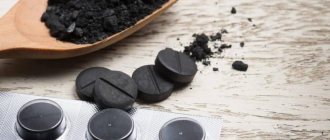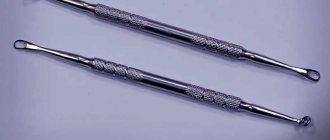Varieties of post-acne
In addition to atrophic scars - a type of post-acne, which we wrote about separately in another article, there are also post-inflammatory erythema and post-inflammatory pigmentation. Today’s article is devoted to these two phenomena.
Before talking about these unpleasant consequences, it is worth understanding where and why a pimple occurs in the first place. A pimple itself is an inflammation that the body does not allow into the blood, namely: at the site of infection, the capillaries narrow, then expand, building a dense defense of leukocytes. They fight infection, after which they restore damaged tissue and create new blood vessels. Visually the pimple goes away.
If the pimple is squeezed out, the natural healing process is disrupted. The infection can get into the blood, the probability of this is quite high. The vessels are certainly injured and leave marks.
Thus, post-inflammatory erythema occurs due to the accumulation of dilated capillaries, which could have been restored to a healthy epidermis if the pimple had not been pressed in this place. Most often, post-inflammatory erythema appears on light skin. Most Russians and Europeans who deal with the problem of post-acne are susceptible to it. Erythema appears as a pink, red, or purple patch left at the site of the pimple. The color is due to injury to the capillaries in the inflamed area. Sometimes erythema goes away on its own within six months, but not always - it all depends on the individual characteristics of the body.
Post-inflammatory pigmentation - brown spots. The color is due to the increased content of melanin, which occurs due to exposure of aggressive sun rays to unprotected, injured skin. Most often, dark-skinned and dark-skinned people, as well as women over 35 years of age, suffer from this disease due to endocrine changes. In most cases, the cause of pigmentation is inflammation of the papulopustular elements of acne, as well as scratching the area of squeezed out pimples.
Dark plaque in children
In children, dark plaque on teeth can be caused by the following factors:
- chromogenic bacteria that produce pigments;
- diseases – dysbacteriosis, disruption of the digestive system;
- change of diet and usual products;
- hereditary predisposition;
- lack of calcium during fetal development and in the first months after birth;
- disruptions in the functioning of the immune system;
- dysfunction of the salivary glands;
- enamel hypoplasia and caries.
The cause of black plaque on a child’s teeth may be the so-called Priestley’s plaque. It occurs even on baby teeth and can appear at any age - both in teenagers and in very young children. Accompanied by an unpleasant odor from the mouth.
This phenomenon is a product of the vital activity of certain bacteria - a black pigment that settles on the enamel. It is safe for molars and for the body as a whole, does not provoke the development of pathologies and goes away on its own over time.
If we talk about how to remove dark plaque from a child’s teeth, professional hygienic cleaning will help, but it is not a guarantee that it will not appear again soon.
Why do post-acne appear?
The unpleasant consequences of acne are always the result of incorrect or insufficient professional treatment. First of all, it is important to maintain hygiene: do not squeeze out the inflammatory element, do not touch it with dirty hands, follow all stages of skin cleansing and the recommendations of a dermatologist.
The causes of post-acne can be different: deep inflammation, long-term struggle with acne, incorrectly selected treatment. All this inevitably leaves unsightly marks, especially the regular squeezing out of inflammatory elements, which, as we said earlier, damages the capillaries.
Factors in the appearance of post-inflammatory erythema are divided according to the nature of the formation into pathological and physiological. The first include:
- infectious diseases or pathologies of the body;
- autoimmune diseases;
- thermal, radiation or chemical burn.
Physiological reasons include:
- physical injury or intense massage;
- certain medications taken in large doses;
- long exposure to the open sun without proper protection.
Mild erythema goes away in a couple of days; in more serious cases, recovery may take several weeks. The speed depends on the individual characteristics of the body: cell regeneration (ability to renew), hormonal levels, deficiency or excess of vitamins, as well as on the cosmetics used to combat post-acne.
The causes of post-inflammatory pigmentation are still not fully understood, but scientists have identified several factors that influence their development. These include:
- stress;
- hormonal disorders;
- infection;
- diet;
- genetic predisposition.
Some experts believe that exposure to the sun does not affect the appearance of post-inflammatory pigmentation, but there is no evidence of this yet.
Introduction
The information world is very huge. Each of us is haunted by a million points of view
for any problem in any field of knowledge, you just need to ask a search query. The same thing happens in medical circles on the Internet - discussions of health problems are widely represented by both patients and doctors and often reach the point of absurdity:
For example, in questions:
- loosening of the tooth,
- exposure of the neck of the tooth,
- why are my gums and teeth exposed?
that is, in situations where the gums on a tooth have receded, patients are always confused: they have periodontal disease
, then suddenly it changed to
periodontitis
, then periodontal disease returned again. And the search for an answer to the question becomes endless.
The problem of “how to treat periodontal disease” is picked up by doctors who only add fuel to the fire by recommending medications and even folk remedies for periodontal disease, without having sufficient competence to do so.
Let's consider these points of view professionally, and try to convey one simple truth, which for the vast majority of patients (and even some doctors) will be a revelation: the diagnosis of periodontal disease of the gums
» —
does not exist
.
An expert point of view is expressed by the famous periodontist, Doctor of Medical Sciences Laura Mikhailovna Tebloeva:
As a rule, for patients who come to me and say: “I have periodontal disease,” I always clarify - did you make this diagnosis yourself or did you see a doctor? Often patients answer that they have this information from their doctor. It turns out that the patient did not read somewhere and determine the diagnosis of “periodontal disease” for himself, but, unfortunately, such a diagnosis was made by a doctor.
How to get rid of acne spots using cosmetology
Excessive spotting does not affect a person’s well-being, but his appearance and emotional state noticeably suffer from such acquisitions. It is logical that the first specialist who is contacted to remove post-acne and stagnant spots is a cosmetologist/dermatologist. In what ways does it help with erythema:
- laser exposure to capillaries;
- gels and ointments that narrow the walls of blood vessels;
- creams, masks and all kinds of peelings.
Experts in the field of cosmetology believe that erythema can disappear on its own in six months to a year. But in the case of post-inflammatory pigmentation, it is much more difficult to get rid of spots. Here are the popular methods that cosmetologists use in their practice:
- Microdermabrasion is the “filing off” of the stratum corneum of the skin. To completely remove post-acne pigmentation, 2-3 sessions are required, and the skin recovers within a month. During this time, you should avoid direct sunlight and refrain from going to the solarium, swimming pool and sauna.
- Mesotherapy with vitamins. It comes in the form of injections with a concentrate of vitamins, nucleic acids, amino acids, and proteins. It can also be applied to the skin with a vitamin cocktail, which is delivered to the deep layers of the epidermis using a laser device or microneedling (multiple skin punctures).
- Photothermolysis. The procedure involves burning out the upper layer of the epidermis, and the thermal effect provokes increased cell regeneration.
- Ozone therapy. Removing pigment spots with ozone. There are three types: meso-ozone therapy, ozone tonic and injections. The first is treating clean skin with a roller with an oxygen-ozone composition. Ozone tonic - rubbing the skin with an ozone cocktail, especially recommended against pigmented brown spots. With ozone injections, an ozone cocktail is injected under the skin, and the injection site visibly swells. Using massage movements, the substance is evenly distributed throughout the problem area.
- Laser facial resurfacing. Requires lengthy preparation: avoid ultraviolet radiation a month before the procedure, start using sunscreen 14 days before, undergo a medical examination, and take urine and blood tests. Acne spots on the face will go away only after a course of procedures, which lasts from 3 to 10 sessions. A rather traumatic method that requires a long period of rehabilitation.
- Dermabrasion. Mechanical damage to the stratum corneum of the skin. It can be superficial, deep and medium. Superficial dermabrasion touches the layers of skin up to the basal membrane, medium touches only the basal level, and deep penetrates to the papillary layer of the epidermis. Painful! There are contraindications.
- Chemical peeling. Organic acids are used that cause a controlled burn and subsequent death of the top layer of skin.
Each of the listed procedures requires a mandatory recovery period and is contraindicated during pregnancy and lactation!
Which pasta should you choose?
This question is very important, since the effectiveness of the product used directly depends on the choice of toothpaste. Follow the main criteria:
- choose only white toothpaste;
- do not purchase a product with a bleaching effect;
- Make sure that the toothpaste contains natural ingredients (this could be chamomile extract, sage, etc.);
- choose a paste with the least amount of fluoride in the composition, since this component sometimes causes redness and irritation on the skin;
- Do not buy a product that contains alcohol - it will dry out the skin too much.
In general, it is important to carefully study the composition of the paste before using it. It should contain fewer chemical components, but what should be more are natural and plant components.
Do not forget to also take into account the individual characteristics of your skin: if a particular substance causes an allergic reaction in you, it should not be in the paste either.
A simple test will help you understand whether you have an allergy or not: apply just a little paste to the inside of your wrist and wait 10 minutes - the absence of itching and burning indicates that it can be used.
Do not use gel paste - this consistency will not work.
offer
How to Get Rid of Acne Spots with Physiotherapy
To increase the effectiveness of cosmetics, physiotherapy is used - in the case of post-acne spots, we recommend using phonophoresis or microcurrents for a more pronounced result.
Today we’ll talk about phonophoresis. With this procedure, the beneficial substances of the gel or cream are delivered to the deep layers of the skin thanks to the influence of ultrasound.
The transferred components accumulate in the form of a medicinal depot in the skin and subcutaneous fat, significantly increasing the effectiveness of the drug and the time of its action. This is why the effect of physiotherapy lasts longer than a course of skin applications.
To conduct a session, you need a medium - a gel or cream with active ingredients that need to nourish the epidermal cells and eliminate the deformed substrate. The cosmetic product is applied only to previously cleansed skin! Since air does not carry ultrasound, you should press the emitter head tightly against the gel/cream application at the site of the problem area.
Next, the required ultrasound frequency is set - the lower the number, the stronger the effect on the body. Thus, at a frequency of 800–1000 kHz, ultrasound penetrates 5–6 cm, and at 2400 kHz, 1–2 cm. In the case of acne spots, a greater depth is not needed to solve a problem not of a medical, but of a cosmetic nature, deeper than 2 cm not worth influencing.
One session of phonophoresis takes 10–15 minutes, depending on the specific case and the severity of pigmentation. To remove red spots from acne, you need to complete a course of 8–15 procedures at intervals of a day or two.
Myths about tooth powder
The main myth is that it causes enormous harm to teeth. In fact, if the teeth are in healthy condition and if all the rules are followed, then harm is practically excluded. Negative changes can only occur if you use the powder on an ongoing basis.
Another common misconception is poor quality plaque cleansing. In fact, according to statistics, this product copes with this task even better than the most expensive toothpaste from a well-known manufacturer.
How to remove acne spots with Fermencol gel
A specially developed Fermenkol line will help remove post-acne spots, aimed at correcting skin texture, normalizing color and restoring healthy tissue. All Fermenkol products contain 9 active collagenase enzymes, which “eat up” the destroyed vascular endothelium, improve local capillary circulation and, as a result, even out skin color.
Fermenkol also eliminates deformed collagen and, penetrating the dermis, acts only on pathological tissue, without affecting intact (healthy) areas of the skin. The result: clean, smooth skin without pigmentation.
To enhance the cosmetic effect, experts recommend using Fermenkol together with phonophoresis. The course of procedures can be completed either in a clinic at your place of residence or at home with a portable Reton device for phonophoresis. You can purchase Fermenkol products by placing an order online on the official website or in pharmacies in your city. Before use, consult a specialist; he will prescribe the optimal number of procedures. It is easy to get a consultation from a practicing doctor; to do this, you need to click the “doctor” button, describe your situation in detail and attach a photo of the damaged area.
Fermenkol products have already helped many people get rid of acne spots, here is just one of the reviews:
Remember! The sooner you start the course, the faster you will achieve the desired result and will again be able to enjoy healthy and beautiful skin.
Always treat gum problems
When a patient comes to the doctor, he complains about something. What symptoms does he see a doctor with before receiving a diagnosis of periodontal disease? What worries him?
Literally, patients tell the doctor this: my gums have sagged, my gums have become exposed, my lower gums have receded. And for some reason the symptom of gum subsidence automatically means that the patient has the so-called. periodontal disease.
More experienced patients, who have already heard a lot of professional terms, who delve into the professional colloquial language of doctors, say this: “The necks of the teeth have become exposed a little, the teeth have become a little higher.” But, according to statistics, most patients complain about sagging gums.
And so, when patients come to the doctor with complaints about the problem of exposed tooth necks, the doctor diagnoses them with periodontal disease. Of course, he begins to treat them. And to treat it specifically for periodontal disease.
But time passes, money also goes away, and the question of why the gums recede and the necks of the teeth become exposed, why the gums recede, has not been resolved. And the patient still has periodontal disease.
Contraindications
Although the ingredients of the scrub seem simple, they can cause harm under certain conditions.
Soda for blackheads is not used if there are a number of contraindications:
- dry and thin skin;
- open wounds;
- severe inflammation;
- allergy to any components of the scrub;
- vascular network on the face.
Attention! It is strictly forbidden to do this peeling for prevention. If there are no problems, the product will only worsen the skin condition.
There is no inflammation with periodontal disease
When does the so-called periodontal disease, there is no inflammatory process in the gums. The clinical picture of “periodontal disease” differs sharply from periodontitis; it is with periodontitis of the tooth that inflammation occurs.
And injections into the gums, endless restorations of the necks of the gums - this is running in circles. Over time, again all the restoration fillings are chipped, and again these patients come to have these fillings restored again. And this happens endlessly
:
And the diagnosis of “periodontal disease” does not go away. As Desna ran away, she continues to leave. The fillings increase, that is, the teeth increase in size, because the gums sag more and more, and nothing useful happens.
When such a patient gets an appointment with me, unwinding his entire tangle of ordeals during the consultation, it becomes clear that all previously performed gum treatment consists of 3
factors:
- Lost time,
- lost money
- shattered hopes.
The diagnosis was incorrect and the treatment was appropriate for the incorrect diagnosis. What went wrong?
Patients should always go for a consultation with such a diagnosis... to an orthodontist
.
Because periodontal disease is an occlusal injury
.
What I see in these patients with signs of periodontal disease is a completely different diagnosis. This is an occlusal injury that can only be corrected by an orthodontist.
